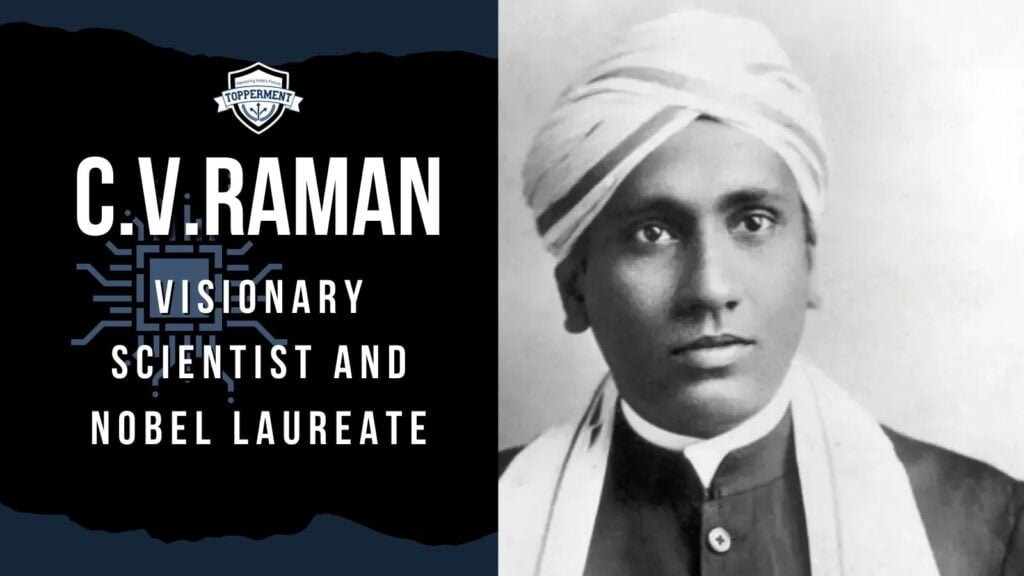Sir Chandrasekhara Venkata Raman, popularly known as C.V. Raman was an Indian physicist who made remarkable contributions to the field of light scattering and discovered the phenomenon of Raman effect, for which he was awarded the Nobel Prize in Physics in 1930. He was the first Asian and the first non-white person to receive a Nobel Prize in any branch of science. He was also a visionary leader who founded several institutions and journals to promote scientific research and education in India.
C.V. Raman Early Life and Education
C.V. Raman was born on November 7, 1888, in Tiruchirapalli, Tamil Nadu, to a Tamil Brahmin family. His father was a lecturer in mathematics and physics, and his mother was a homemaker. He was aprodigy who completed his secondary and higher secondary education from St Aloysius’ Anglo-Indian High School at the age of 11 and 13, respectively. He topped the bachelor’s degree examination of the University of Madras with honours in physics from Presidency College at age 16. His first research paper, on diffraction of light, was published in 1906 while he was still a graduate student. The next year he obtained a master’s degree with the highest distinction.
C.V. Raman Career and Research
Despite his passion for physics, Raman joined the Indian Finance Service in Calcutta as Assistant Accountant General at age 19, due to financial constraints and lack of opportunities for scientific research in India at that time. However, he did not give up his interest in physics and continued to pursue independent research at the Indian Association for the Cultivation of Science (IACS), the first research institute in India, where he had access to a laboratory and equipment. There he made his major contributions in acoustics and optics, such as studying the vibration of strings, musical instruments, ultrasonic waves, and the scattering of light by liquids.
In 1917, he was appointed the first Palit Professor of Physics by Ashutosh Mukherjee at the Rajabazar Science College under the University of Calcutta. He established a school of physics there and attracted many talented students and researchers. He also founded the Indian
Journal of Physics in 1926, which became a platform for publishing original research papers from India.
In 1928, he made his most famous discovery of the Raman effect, which is the change in wavelength and frequency of light when it passes through a transparent material. He used a spectrograph that he developed to observe this phenomenon, which was previously unknown and unexpected. He and his student K.S. Krishnan published their findings in Nature, which created a sensation in the scientific world. The Raman effect proved that light is composed of particles called photons, which can interact with molecules and change their energy states. This opened up new possibilities for studying the structure and properties of matter using light.
In 1930, Raman received the Nobel Prize in Physics for his discovery of the Raman effect. He was the first Indian and the first Asian to win this prestigious award. He was also knighted by King George V in the same year.
In 1933, he moved to Bangalore to become the first Indian director of the Indian Institute of Science (IISc), where he continued his research on various topics such as crystallography, magnetism, diamond, colloids, and biophysics. He also founded the Indian Academy of
Sciences in 1934, which aimed to promote scientific excellence and disseminate scientific knowledge.
In 1948, he retired from IISc and established his own institute, the Raman Research Institute (RRI), where he devoted himself to his lifelong passion for optics. He studied various aspects of light such as fluorescence, diffraction, polarization, colour vision, and optical illusions. He also collected a large number of rare specimens of minerals, crystals, gems, shells, butterflies, etc., which he used for his experiments and displayed in his museum.
C.V. Raman Awards and Honours
Apart from the Nobel Prize and knighthood, Raman received many other awards and honours for his outstanding contributions to science. Some of them are:
Fellow of the Royal Society (1924) Matteucci Medal (1928)
Hughes Medal (1930)
Bharat Ratna (1954) Lenin Peace Prize (1957)
He also received honorary doctorates from various universities around the world, such as Oxford University, Edinburgh University, Paris University, etc.
C.V. Raman Legacy and Impact
C.V. Raman passed away on November 21, 1970, leaving behind a legacy of scientific discovery and innovation. His contributions to the field of physics have continued to inspire generations of scientists and researchers, both in India and around the world. He remains one of India’s most respected and celebrated scientific minds.
Some of the ways in which his legacy and impact are evident are:
The Raman effect is widely used in various fields such as chemistry, biology, medicine, material science, etc., for identifying and characterising molecules and materials. It has applications in areas such as forensic science, drug analysis, environmental monitoring, art restoration, etc.
The Raman spectroscopy, which is the technique of using the Raman effect for analysis, has become a powerful and versatile tool for scientific research and industry. It has led to the development of various instruments and devices such as Raman microscope, Raman laser, Raman spectrometer, etc.
The National Science Day is celebrated in India on February 28 every year, to commemorate the discovery of the Raman effect by C.V. Raman on this date in 1928. The day aims to spread awareness and appreciation of science among the public, especially the youth.
The Ramanujan-Raman Centre for Physics was established at Presidency College in Chennai in 2006, to honour the two eminent alumni of the college, C.V. Raman and Srinivasa Ramanujan. The centre conducts research and teaching in physics and mathematics.
The Raman Chair was instituted by the Government of India in 1972, to invite distinguished scientists from abroad to visit India and deliver lectures at various institutions. Some of the eminent scientists who have occupied this chair are Paul Dirac, Abdus Salam, John Wheeler, etc.
The Raman Medal is awarded by the Indian National Science Academy (INSA) every year, to recognize outstanding contributions to physical sciences by Indian scientists. Some of the recipients of this medal are Homi Bhabha, Vikram Sarabhai, M.G.K. Menon, etc.
The Raman Research Institute (RRI) continues to be a premier institute for research in physics and allied sciences in India. It has made significant contributions in areas such as astrophysics, cosmology, liquid crystals, photonics, etc.
The C.V. Raman International Fellowship for African Researchers was launched by the Government of India in 2010, to promote scientific cooperation and exchange between India and Africa. The fellowship provides opportunities for African researchers to visit Indian institutions and work on collaborative projects.
The C.V. Raman Global University was established in Bhubaneswar, Odisha, in 1997, as a private university offering courses in engineering, management, pharmacy, etc. The university aims to provide quality education and research with a global perspective.
Sir C.V. Raman was a brilliant physicist who made India proud with his Nobel Prize-winning discovery of the Raman effect. He was also a visionary leader who founded several institutions and journals to foster scientific research and education in India. He left behind a rich legacy of scientific excellence and innovation that continues to inspire and influence many people across the world. He is rightly regarded as one of the greatest scientists of all time.
Also Read
Sir M Visvesvaraya: The Engineer-Statesman Who Made Modern India
Unveiling The Thermosphere: Earth’s Fiery Upper Layer-Topperment
Akbar’s Concept of Suzerainty: A Vision of Unified Governance | UPSC History
Follow Us For More Content On:
https://www.instagram.com/topperment/
Tag:C V Raman, IAS, IFS, India, IPS, IRS, National Personalities, Nobel Prize, UPSC


